News
Interview with Chris Hardy
 Chris Hardy, ASLA / © Sasaki Associates, Inc.
Chris Hardy, ASLA / © Sasaki Associates, Inc.
You recently launched a fully revamped version of Carbon Conscience, a platform you developed at Sasaki and as part of your Landscape Architecture Foundation Fellowship for Innovation and Leadership. Who is the platform for and what does it do? And how can it be used to reduce greenhouse gas emissions and increase carbon sequestration?
The purpose of Carbon Conscience is to make it easier to have an intuitive understanding of the climate impacts of design proposals. It's designed for early-phase design work. It's for landscape architects, architects, urban planners, and urban designers. It's even for community advocates who may want to get a better grasp of the carbon potential of what's being proposed.
For example, if there's a multi-housing family development with multiple buildings and landscape, the designer of the project could sketch out architecture and landscape land uses and get a high-level understanding of the carbon impacts of building that project, focusing on the embodied carbon in construction.
Embodied carbon is what it takes to build the project; the carbon emitted to produce, ship to site, and install the construction materials. There's also a way to tally biogenic stored carbon, which is the carbon locked up in things like wood materials, or sequestered carbon, which is the carbon drawn down out of the atmosphere by planting and restored ecosystems. We accounted for the probable carbon sequestered by living systems over a period of 60 years, to correlate with the typical lifecycle study period for buildings.
What we realized using Pathfinder, Tally, and other tools is you usually need detailed quantities of materials in a project before you can get a meaningful estimate of the global warming impacts of a given project. The problem with that is the biggest potential for change is in the earlier design phases, when maybe you're fundamentally challenging or deciding what the framework of a project is.
What are some of the new features of Carbon Conscience v2 you're particularly excited about?
In version 2, we created an entirely new landscape baseline materials database. There are now over 140 different landscape materials with carbon factors that include mean values as well as low and high standard deviation. Carbon factors are how much carbon it takes to make a given material. For example, a carbon factor for concrete would be so many kilograms of carbon dioxide equivalent per kilogram of concrete. With version 2, we have a much more accurate and defensible tool.
We were also able to get user feedback from the version 1 beta testers. We realized we had two types of users. We have what I like to call the noodlers, who wanted to sketch something simple, test it, and see how things work. The second group were the deep dive users who wanted to gamify the tool. They wanted to use the tool more actively -- to test, iterate, and get more sophisticated material options.
In Version 2, we've made things a lot easier for the noodlers. We've reconstructed the user experience to be more intuitive. We're going to post new user tutorials. And we also made it more open to planners who might not be in technical drawing tools on a day-to-day basis. For the deep dive folks, we provided the ability to use a lot more materials and land use options, and the ability to edit assumptions for those land uses.
What do you see as the main differences with Pathfinder, created by Pamela Conrad as part of Climate Positive Design?
Carbon Conscience is a scale bigger than individual sites that might be put in the Pathfinder. And it's a phase or two earlier.
In Pathfinder, you need to know how many square meters or square yards of different paving, furnishings, etc, and numbers of trees. You may not know that at a planning phase. You can use Carbon Conscience even before there's a defined project to bid on, when you have a rough idea of what the project is or could be, and you want to evaluate options. Carbon Conscience is for planning and concept design phases only.
Once you go beyond those phases, it would be best, as a workflow, for landscape architects to transfer their project into Pathfinder. We're working with Pamela to connect our APIs, so projects can graduate from Carbon Conscience into Pathfinder. And Pathfinder is going to refer to our dataset as they move forward with their updated version this coming year. We're very closely linked with Pathfinder and collaborating with the Climate Positive Design team.
Carbon Conscience also has an architectural dataset sourced from the Carbon Leadership Forum. It's at a whole building lifecycle analysis approach, averaged out by floor-level of resolution. And we're going to be moving forward with collaborating with the Epic tool by EHDD in Version 3, which will be coming this fall.
You've used the Carbon Conscience platform to make smart planning and design decisions for the 600-acre Ellinikon Metropolitan Park in Athens, Greece, which will transform an abandoned airport into what will be the largest coastal park in Europe. You have stated the top three carbon reduction strategies of the project were: 1) swapping out imported soils for amended soils; 2) reducing the need for new concrete by using other materials; 3) reusing concrete found on site. How did you use the platform to figure this out?
When we started the Ellinikon, we had a high-level master plan for the park and public space authored by Foster Partners and their team. In the beginning of our engagement, we were asked to create a concept plan. We started by mapping out the Foster plan in Carbon Conscience, using that as a benchmark. We quickly realized that it was going to be very difficult, if not impossible, for us to be climate neutral before our restored ecosystems would hit their carbon carrying capacity.
I wanted to define that term, because I think it's something that we all need to be aware of as landscape architects. The carbon carrying capacity for an ecosystem is how much carbon an ecosystem can reasonably store and sequester by the time it hits maturity. In most ecosystems, as they age and become fully mature, they store less and less carbon. They become relatively static carbon stores. But that's not true of all ecosystems. Wetlands are different, and I can talk about that for a whole hour. But for Ellinikon, this was critical, as Mediterranean ecosystems generally store and sequester much less carbon than temperate or tropical humid forests.
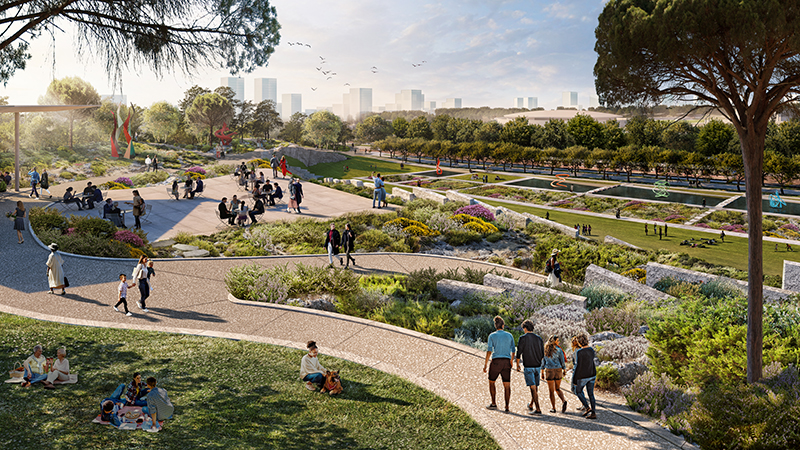 Ellinikon Metropolitan Park, Athens, Greece / © Sasaki Associates, Inc.
Ellinikon Metropolitan Park, Athens, Greece / © Sasaki Associates, Inc. 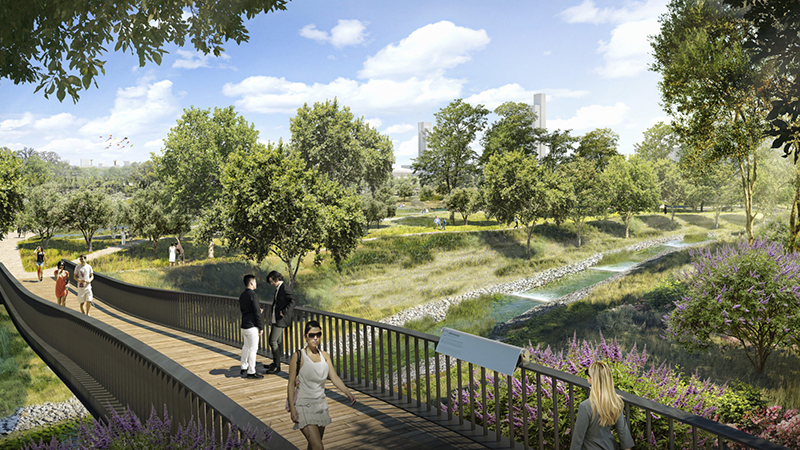 Ellinikon Metropolitan Park, Athens, Greece / © Sasaki Associates, Inc.
Ellinikon Metropolitan Park, Athens, Greece / © Sasaki Associates, Inc. What we realized in our early sketches of Ellinikon is that we needed to change business as usual. We started looking at different strategies in Carbon Conscience, which gave us a way to include the client in the discussion. We even had the client come into the tool themselves, so they could play with the assumptions and start tweaking them with us in workshops. They became personally invested in the development of the project carbon goals, and that gave our team the social capital to challenge business as usual assumptions in site design as we moved forward into technical documentation phases.
As we used the tool, we decided to hugely reduce the amount of paving and increase the area dedicated to restoration style planting, as opposed to gardenesque planting or lawns. Now in the final design, the only lawns in the project have to work for a living. They're for active uses, sports events. Ornamental horticulture is almost entirely defined by aromatic gardens that are passively maintained in that climate. And about 70 percent of the site is now restoration-style ecology.
We also used it to challenge our material assumptions. If we were swapping out our concrete hardscapes for resin-bonded aggregate hardscape or a salvaged concrete hardscape, that gave us huge savings.
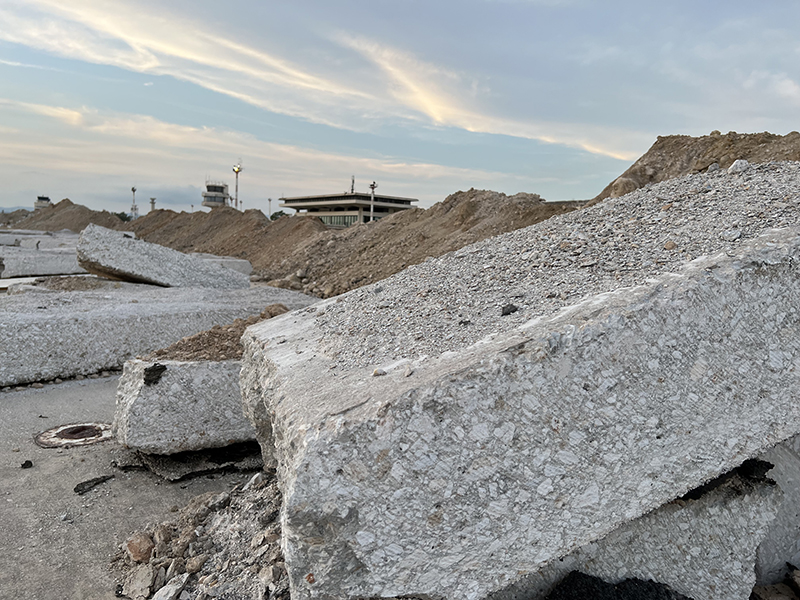 At Ellinikon Metropolitan Park, Sasaki is mining the existing site for reclaimed concrete material for upcycling as wall and furniture elements and downcycling for rip rap and road base. / © Sasaki Associates, Inc.
At Ellinikon Metropolitan Park, Sasaki is mining the existing site for reclaimed concrete material for upcycling as wall and furniture elements and downcycling for rip rap and road base. / © Sasaki Associates, Inc. 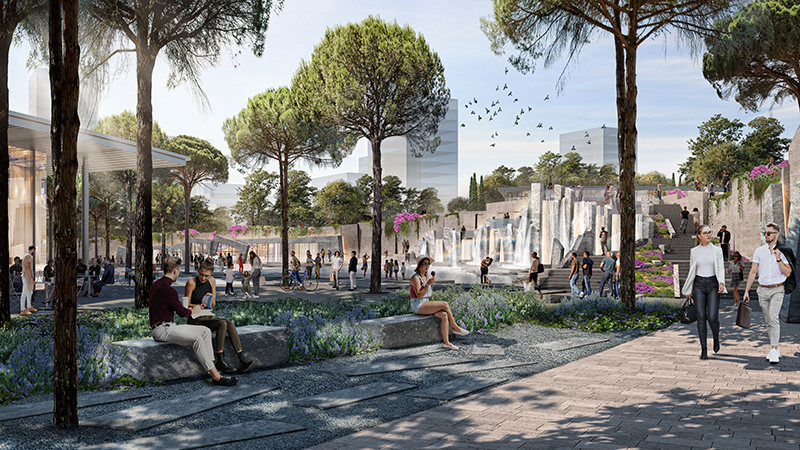 Ellinikon Metropolitan Park, Athens, Greece / © Sasaki Associates, Inc.
Ellinikon Metropolitan Park, Athens, Greece / © Sasaki Associates, Inc. In the design guidelines released with Carbon Conscience, you outlined seven principles designers can follow to reduce the climate impacts of their projects. One is to prioritize reuse. How can landscape architects reuse materials they find on existing sites they may be redesigning? And what do you think is needed to make reuse more cost effective at smaller scales?
Cost efficiency is totally dependent on the quality and scale of the material. In some cases, it can be a lot cheaper if you're just resurfacing asphalt pavement and not resetting it. If you're just re-setting existing cobbles in a particular streetscape, that's extremely cost effective. It gets trickier when you're doing substantial amounts of work to the material itself. For example, if you want salvaged concrete -- let's say crushed salvaged concrete for riprap in a very small site -- that might not be cost feasible.
If you have a site an acre or more, specialized equipment like concrete crushers can be viable. But in the United States, we're already diverting over 50 percent of our construction waste to some kind of salvaged facility, and that includes lot of concrete work. There's already some efficiency where you can salvage aggregates coming from demolition debris in most major metropolitan areas.
A big part of reuse is also thinking about the end-of-life of our designs and materials. It's a lot easier to crush, salvage, and reuse, or up-cycle or down-cycle concrete if it doesn't have steel reinforcing in it. Without steel reinforcement, you can start cutting it like stone. If we think about our concrete pavement profiles, maybe we make them a little thicker to avoid having steel in them, so that in the next generation of that concrete pavement, it'll be a lot easier to salvage it for reuse.
In the guidelines you also call for using natural and locally-sourced materials wherever possible. What are the climate benefits of these approaches? And are there projects that have done this that inspire you?
When we can avoid emissions associated with the making of the material itself -- like the emissions that go into making clinker for cement, smelting for metals, or complex hydro-chemical processes to make plastics -- that dramatically reduces the carbon factors of the material itself.
When we specify natural materials, the material is there; it just needs to be cut, shaped, and moved. And those emissions can be a lot less. I'm talking about things like stone, aggregate, wood, bamboo, and rammed earth, which are naturally occurring and just need be manipulated to become construction products.
When we talk about locally-sourced materials, we're avoiding the transportation carbon cost that regional or more distant materials can have. Unfortunately, in the United States almost all of our transportation for construction materials is generally truck, which can have the highest carbon factor of almost any typical transportation options. Local sourcing becomes a huge factor for landscapes in particular, because most of our materials are massive and come at a high carbon transportation cost.
Right now, I'm focused on our Ellinikon project in Greece where we are trying to locally source most of the materials on site. We have the benefit of having stone quarries less than 20 miles from the site. And we have the benefit of mining material on the site. There's a wonderful opportunity when you think about sourcing local stone in particular, because usually you're tapping into a vernacular, a material tradition. There are regional craftsmanship traditions people take pride in.
And in the States, we have designed a number of projects at Sasaki where we sourced more local or vernacular stones, such as at our University of Texas at Austin Dell Medical District and Baylor University projects.
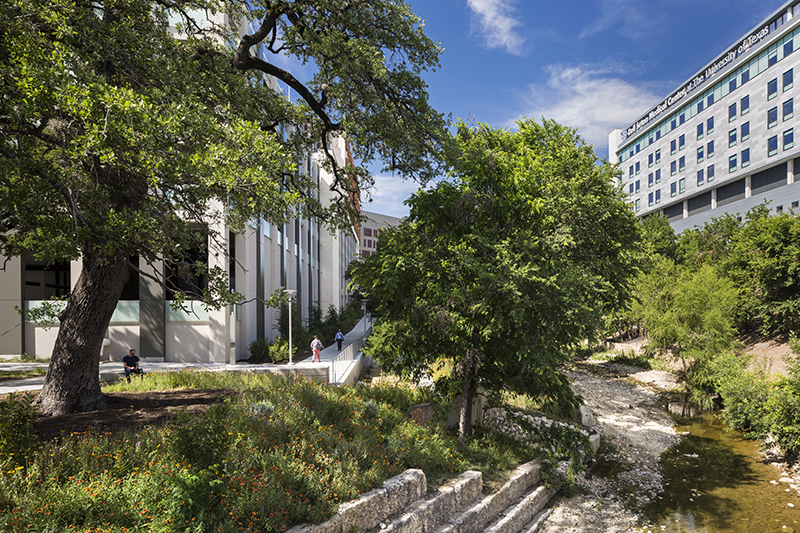 At the University of Texas - Austin Dell Medical District, Cordova Cream Limestone, which is found near Austin, were used for seat walls and retaining walls at Waller Creek. / © Sasaki Associates, Inc.
At the University of Texas - Austin Dell Medical District, Cordova Cream Limestone, which is found near Austin, were used for seat walls and retaining walls at Waller Creek. / © Sasaki Associates, Inc. 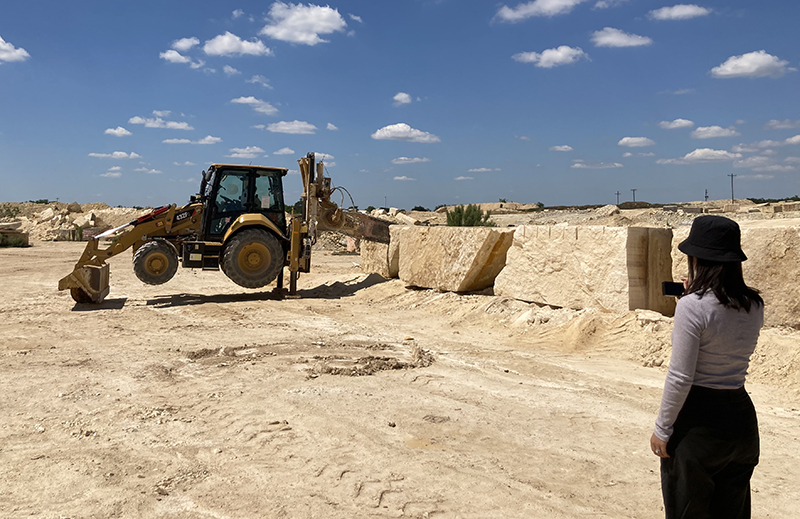 For Baylor University Founders Mall, Lueders Limestone, which is found near Abilene, Texas, was used for fountain walls, seat walls, narrative walls, and crushed self-stabilized paving. / © Sasaki Associates, Inc.
For Baylor University Founders Mall, Lueders Limestone, which is found near Abilene, Texas, was used for fountain walls, seat walls, narrative walls, and crushed self-stabilized paving. / © Sasaki Associates, Inc. You also emphasize the value of nature-based solutions and promoting ecological preservation and restoration. How do healthy ecosystems and nature-based solutions create positive climate outcomes? Do biodiverse, ecologically-rich landscapes store more carbon?
Only in living systems do we have economically viable ways to draw carbon out of the atmosphere. Geoengineering solutions are speculative businesses. Trees and plants are very efficient at what they do. And it's very hard for technology to replicate those processes in an economically viable way.
One of the great benefits of nature-based solutions is the co-benefits. Rain gardens not only contribute to stormwater management but reduce the fundamental need for grey infrastructure. They're replacing the concrete pipes and catch basins. And in the right context, they're a high-carbon sequestrating landscape. And when you start layering in biodiversity benefits, it becomes an even richer proposal.
Biodiversity is more of a correlation with carbon sequestration than a causation. For example, a Spartina salt marsh is not the most biodiverse planting design but it is super carbon sequestering. However, when you compare two different landscapes, the more structurally complex an ecosystem is -- the more trophic levels, the more physical levels of living organisms, such an overstory, an understory, and rich mycorrhizal horizon in the soils -- the more carbon it is going to store. And it will usually be more biodiverse than a structurally simplistic ecosystem. What we want is structural diversity and complexity; we want resilient, complex, adapted ecosystems.
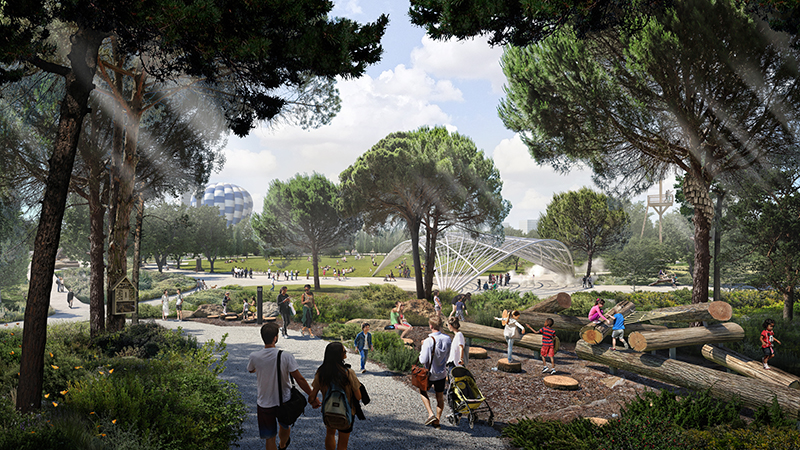 Ellinikon Metropolitan Park, Athens, Greece / © Sasaki Associates, Inc.
Ellinikon Metropolitan Park, Athens, Greece / © Sasaki Associates, Inc. Most kinds of forest have a carbon carrying capacity, but many wetlands and some prairie do not. Wetlands offer a linear rather than sigmoidal sequestration of carbon. Over the long-term, wetlands can be incredibly high performance from a carbon perspective. Maybe the solution isn't always planting trees to offset a project. Maybe it is protecting or investing in the restoration of a wetland or a prairie.
Chris Hardy, ASLA, is senior associate at Sasaki. He is founder of Carbon Conscience and Co-chair of the ASLA Climate Action Committee Subcommittee on Carbon Drawdown and Biodiversity. He was a 2022-2023 Landscape Architecture Foundation Innovation and Leadership Fellow.